Declaring a Pointer To define a pointer use an asterisk in
Declaring a Pointer
To define a pointer, use an asterisk, (*), in the declaration to specify the variable will be a pointer to the specified data type.
Recall that the name of an array holds the memory address of the first element of the array. The second statement then would store the memory address of the first value in the variable valuePtr.
The name of a pointer is an identifier and must follow the rules for defining an identifier. Some programmers place the letters ptr, a common abbreviation for pointer, at the end of the variable name, others prefix a pointer with p_ or ptr_, and there are those who do nothing to distinguish a pointer by its name. The naming of a pointer variable is a matter of programming style.
Once a pointer has been declared and initialized, it can be used to access the data to which it points. In order to access this value, the dereference operator, *, must be used to prefix the name of the pointer. From the code above, valuePtr holds the address of the first element of the values array; therefore, *valuePtr will access the value 325. Add the following to main and execute the program.
The output generated should look something like the following.
Where 0xbfad43e8 is a memory address displayed in hexadecimal.
Obtaining the Memory Address of a Variable
The address operator, &, is used to determine the memory address of a variable that is not an array. Add code necessary to use fixed and setprecision, then add the following to main and run the program to confirm the use of the address operator.
Using a Pointer to Alter Data
Just as the dereference operator is used to retrieve data, so too is it used to store data. Add the following to function main and run the program.
The pointer, ratePtr, is used to change the data stored in payRate. The output of payRate confirms the change.
Using a Pointer in an Expression
As previously shown, the value pointed to by a pointer variable can be retrieved by dereferencing the pointer. In the above code, the retrieved value was simply displayed to the screen; however, it can also be used in an expression. Add the following to main and execute the program.
Pointer Arithmetic
It is possible to add to or subtract from a memory address stored in a pointer. These actions can be accomplished using the addition operator,+, subtraction operator, - and the increment and decrement operators, ++ and --. This is helpful when accessing arrays via pointers.
The increment operator has been used to add the value 1 to a variable. When used with a pointer, the increment operator adds the size of the data referenced to the memory address stored in the pointer, effectively moving the pointer to the next data value. Building on the code from above, add the following to main and execute the program.
We initialized valuePtr to the memory address of the first element of the array values. Incrementing valuePtr instructs the computer to add four bytes, the size of an integer, to the memory addressed stored in valuePtr. After the increment, valuePtr now points to the second element of the array.
The addition operator, +, works in a similar fashion. Add the following to function main and execute the program.
Note that the value stored in valuePtr is not modified by this code. valuePtr currently points to the second element in the array. The program interprets the instruction to add two, *(valuePtr + 2), as add two times the size of an integer to the contents of valuePtr and access that address; this would be the fourth element of the array. The next line of code allows the confirmation of the interpretation of the addition by displaying the value in the fourth element of the array.
The last line of code is included to demonstrate the need for the parenthesis when using the dereference operator when using the addition operator to alter the memory address. Add code to test the necessity of using parenthesis with the increment operator.
The subtraction and decrement operators perform in a similar manner.
Pointers as Parameters
As with any other variable, pointers may be passed to functions as parameters. In a previous lab, a memory addressed was passed to a function using a reference parameter. The idea here is the same, only the syntax has changed.
A pointer parameter is specified using the same syntax as a pointer declaration. Within the function itself, the pointer is used as before; the name of the pointer holds the memory address and the data can be accessed by dereferencing the pointer.
Add the following function to the program.
The function call must match the function definition. The function definition has specified that the function expects a memory address; the function call must therefore send the function a memory address. Add the following to main and execute the program.
Because the pointer is a memory address, changes to the data value within the function will be seen outside the function.
When passing an array via a pointer, the data values can be accessed using array notation or pointer notation. Add the following to the program.
Add the following to function main and execute the program.
The name of an array holds the memory address of the first element of the array; therefore, the name of an array is essentially a pointer to the first element of the array. Recall that the index specified within the [] operator, in array notation, instructs the computer to move that many elements from the first element. The computer calculates the distance to move using the same method as pointer arithmetic; the index value is multiplied by the size of the data type to determine the distance to move from the memory address of the first element.
Just to help you practice with pointer math, replace the previous array notation version of displayArray with the following pointer notation version and execute the program.
One final array notation option exists for the displayArray function. While an array name\'s value cannot change, a pointer\'s value can change. When an array is declared, the name of the array holds the memory address of the first element. If this value could be changed, there would be no way to retrieve the original memory address and data would be lost. The name of an array is a constant pointer. The pointer itself cannot change. When passing an array to a function, the memory address is passed to a pointer; this pointer is not a constant pointer and can be changed. There is no danger in changing the pointer\'s value (or memory address) in the function as the name of the array, in the calling function, still holds the original memory address. Replace the previous pointer notation version of displayArray with the following pointer notation version and execute the program.
Dynamic Memory Allocation
A variable declaration reserves memory for a variable. The amount of memory to be reserved must be known by the programmer. However, there are instances when the programmer may not know the exact amount of memory that will be needed by those that will use the program. As an example, recall from a previous lab the declaration of an array to store student scores. As the number of students was unknown, the array was declared large enough to store scores for double the largest expected class size. This approach works well until the assumption of the expected class size is no longer valid.
A better approach might be to reserve the amount of memory needed at the time of the program\'s execution. In this example, that would require the program to first determine the number of students in the class, and then reserve that amount of memory. However, when declaring an array, the size must be an integer constant or literal; it cannot be a variable.
The new Operator
The new operator allows the program to dynamically, at run-time, reserve memory. The new operator has one operand on its right which specifies the amount, or size, of memory to allocate. The new operator returns the memory address of the allocated memory.
Where size_to_allocate is typically a data type and pointerName has been declared a pointer of that type.
Once allocated, the memory can be accessed via the pointer as discussed previously. It is important to note that memory allocated in this way is not initialized just as local variables are not. Be sure to initialize the memory before accessing it in an expression.
The delete Operator
Once memory has been allocated using new, the memory is accessible until it is released using the delete operator. The delete operator releases any memory obtained by new so that it can be used for other purposes either later in the program or by another process running concurrently on the computer.
Add the following to function main and execute the program.
delete must never be used to release any memory not obtained via new. The address nullptr is reserved so that any attempt to dereference a pointer to that address will fail. You should always set an owning pointer to nullptr after freeing the memory that it was managing, since the address of that (now deallocated) memory is still stored in the pointer; leaving it intact opens you to the possibility of accidentally making use of a storage location that no longer belongs to your program.
new[] and delete[]
Use the [] operator in conjunction with new to dynamically allocate an array.
Where arrayName has been declared a pointer to the specified data type. This instruction will allocate size_of_array many elements of data_type. As with any array, the elements will occupy consecutive memory addresses. As with any locally declared variable, the memory is not initialized.
Use the [] operator in conjunction with delete to release any memory allocated with the new[] operator.
Add the following to the program.
Add the following to function main and execute the program.
This code will reserve enough consecutive space in memory to store ten integers and the address of the first element will be stored in the pointer variable moreValues.
While this code will dynamically allocate memory for the array, the literal 10 in the code still forces the programmer to determine the amount of memory needed prior to execution of the program. With new the programmer is no longer constrained to use a constant or literal to specify the size of the array. Replace the previous code in main with the following and execute the program.
With this code, the programmer is no longer forced to decided memory usage prior to the program\'s execution. Here, the user specifies the number of elements that will be needed; that amount of memory and only that amount of memory is reserved.
Memory allocated using new remains available until it is released. delete need not be used within the function using new. To demonstrate, modify the getData function as follows.
Then modify main as follows and execute the program.
| Code Illustration |
Solution
solution
#include<stdio.h>
#include<iostream>
using namespace std;
int main()
{
int values[5] = {325, 879, 120, 459, 735};
int *valuePtr = values;
cout<<\"the expected output\"<<endl;
cout << \"valuePtr: \" << valuePtr << endl;
cout << \"*valuePtr: \" << *valuePtr << endl << endl;
}
output
the expected output
valuePtr: 0x22fe20
*valuePtr: 325
//using a pointer to display the data
#include<stdio.h>
#include<iostream>
#include<iomanip>
using namespace std;
int main()
{
double payRate = 7.25;
double *ratePtr = &payRate;
cout << fixed << setprecision(2);
cout << \"address of payRate: \" << ratePtr << endl;
cout << \"data store in payRate: \" << *ratePtr << endl << endl;
}
output
address of payRate: 0x22fe30
data store in payRate: 7.25
//use pointer to alter the data
#include<stdio.h>
#include<iostream>
#include<iomanip>
using namespace std;
int main()
{
double payRate = 7.25;
double *ratePtr = &payRate;
cout << fixed << setprecision(2);
cout << \"address of payRate: \" << ratePtr << endl;
cout << \"data store in payRate: \" << *ratePtr << endl << endl;
*ratePtr = 10.50;
cout << \"altered value of payRate: \" << payRate << endl << endl;
}
output
address of payRate: 0x22fe30
data store in payRate: 7.25
altered value of payRate: 10.50
//array values
#include<stdio.h>
#include<iostream>
#include<iomanip>
using namespace std;
void displayArray(int *array, int size)
{
cout << \"Array values: \ \";
for (int i=0; i < size; i++)
cout << array[i] << endl;
cout << endl;
}
int main()
{
int values[]={1,2,3,4,5} ;
displayArray(values,5);
}
output
array values
1
2
3
4
5
//array values
#include<stdio.h>
#include<iostream>
#include<iomanip>
using namespace std;
void displayArray(int *array, int size)
{
cout << \"Array values: \ \";
for (int i=0; i < size; i++)
cout << *(array + i) << endl;
cout << endl;
}
int main()
{
int values[]={1,2,3,4,5} ;
displayArray(values,5);
}
output
Array values:
1
2
3
4
5
//allocate the size dynamically
#include<stdio.h>
#include<iostream>
#include<iomanip>
using namespace std;
void displayArray(int *array, int size)
{
cout << \"Array values: \ \";
for (int i=0; i < size; i++,array++) // \"moves\" the pointer
cout << *array << endl;
cout << endl;
}
int main()
{
//int values[]={1,2,3,4,5} ;
int* values = NULL; // Pointer to int, initialize to nothing.
int n;
cout<<\"enter the size needed for array\"<<endl;
cin >> n; // Read in the size
values = new int[n]; // Allocate n ints and save ptr in a.
for (int i=0; i<n; i++) {
values[i] = i; // Initialize all elements to zero.
}
displayArray(values,n);
}
output
enter the size needed for array
6
Array values:
0
1
2
3
4
5
program
#include<stdio.h>
int main()
{
double *dv = new double;
*dv = 88.25;
cout << \"address of dv: \" << dv << endl;
cout << \"value of dv: \" << *dv << endl << endl;
delete dv;
dv = NULL; // NULL the pointer so that it cannot accidentally be dereferenced again.
}
output
address of dv: 0x537410
value of dv: 88.25
0
//program
#include<stdio.h>
#include<iostream>
#include<iomanip>
using namespace std;
void displayArray(int *array, int size)
{
cout << \"Array values: \ \";
for (int i=0; i < size; i++,array++) // \"moves\" the pointer
cout << *array << endl;
cout << endl;
}
void getData (int *array, int size)
{
for (int i=0; i<size; i++)
{
cout << \"Enter value \" << i + 1 << \": \";
cin >> array[i];
}
}
int main()
{
int *moreValues = new int[10];
getData(moreValues,10);
displayArray(moreValues,10);
delete [] moreValues;
}
output
Enter value 2: 2
Enter value 3: 3
Enter value 4: 4
Enter value 5: 5
Enter value 6: 6
Enter value 7: 7
Enter value 8: 8
Enter value 9: 9
Enter value 10: 10
Array values:
0
2
3
4
5
6
7
8
9
10
//program
#include<stdio.h>
#include<iostream>
#include<iomanip>
using namespace std;
void displayArray(int *array, int size)
{
cout << \"Array values: \ \";
for (int i=0; i < size; i++,array++) // \"moves\" the pointer
cout << *array << endl;
cout << endl;
}
void getData (int *array, int size)
{
for (int i=0; i<size; i++)
{
cout << \"Enter value \" << i + 1 << \": \";
cin >> array[i];
}
}
int main()
{
int numberOfMoreValues;
cout << \"How many more values would you like to enter? \";
cin >> numberOfMoreValues;
int *moreValues = new int[numberOfMoreValues];
getData(moreValues,numberOfMoreValues);
displayArray(moreValues,numberOfMoreValues);
delete [] moreValues;
moreValues =NULL; // NULL the pointer for safety.
}
output
How many more values would you like to enter? 10
Enter value 1: 1
Enter value 2: 2
Enter value 3: 3
Enter value 4: 4
Enter value 5: 5
Enter value 6: 6
Enter value 7: 7
Enter value 8: 8
Enter value 9: 9
Enter value 10: 10
Array values:
1
2
3
4
5
6
7
8
9
10
//program
#include<stdio.h>
#include<iostream>
#include<iomanip>
using namespace std;
void displayArray(int *array, int size)
{
cout << \"Array values: \ \";
for (int i=0; i < size; i++,array++) // \"moves\" the pointer
cout << *array << endl;
cout << endl;
}
int *getData (int &numberOfMoreValues)
{
cout << \"How many more values would you like to enter? \";
cin >> numberOfMoreValues;
int *dynamicArray = new int[numberOfMoreValues];
for (int i=0; i<numberOfMoreValues; i++)
{
cout << \"Enter value \" << i + 1 << \": \";
cin >> dynamicArray[i];
}
return dynamicArray;
}
int main()
{
int numberOfMoreValues;
int *moreValues = getData(numberOfMoreValues);
displayArray(moreValues,numberOfMoreValues);
delete [] moreValues;
moreValues = NULL; // NULL the pointer for safety.
}
output
How many more values would you like to enter? 5
Enter value 1: 20
Enter value 2: 30
Enter value 3: 40
Enter value 4: 50
Enter value 5: 60
Array values:
20
30
40
50
60
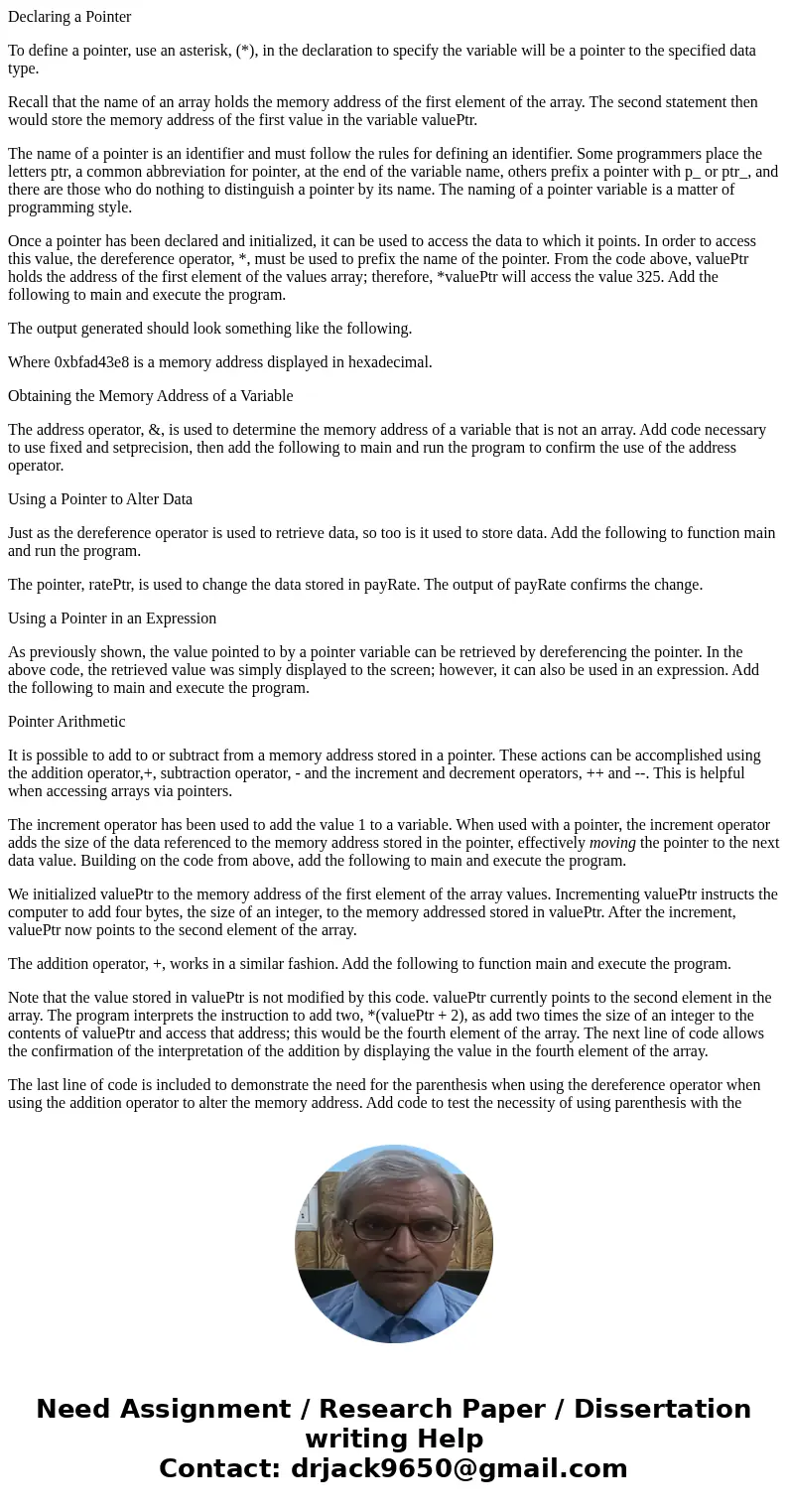
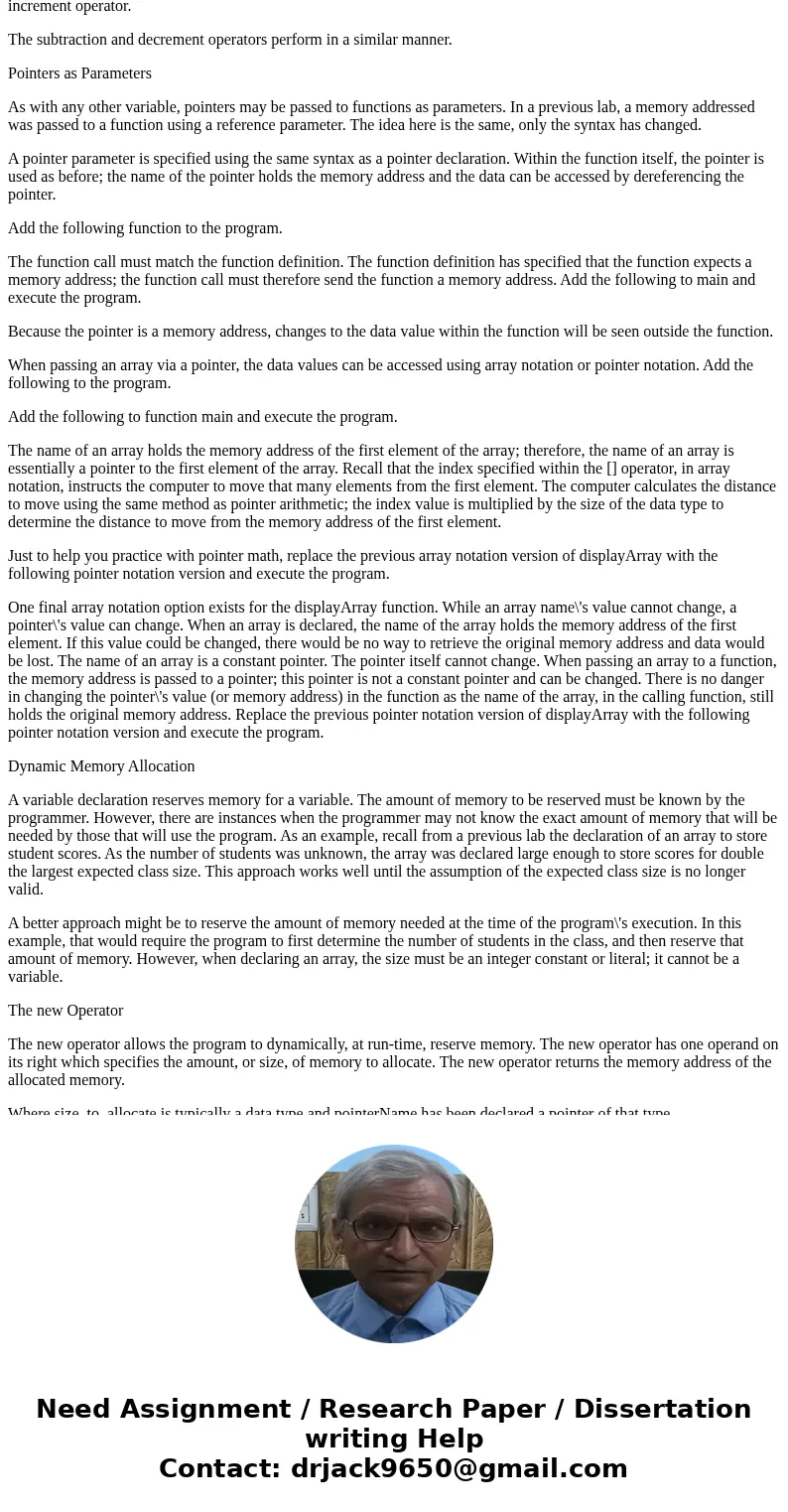
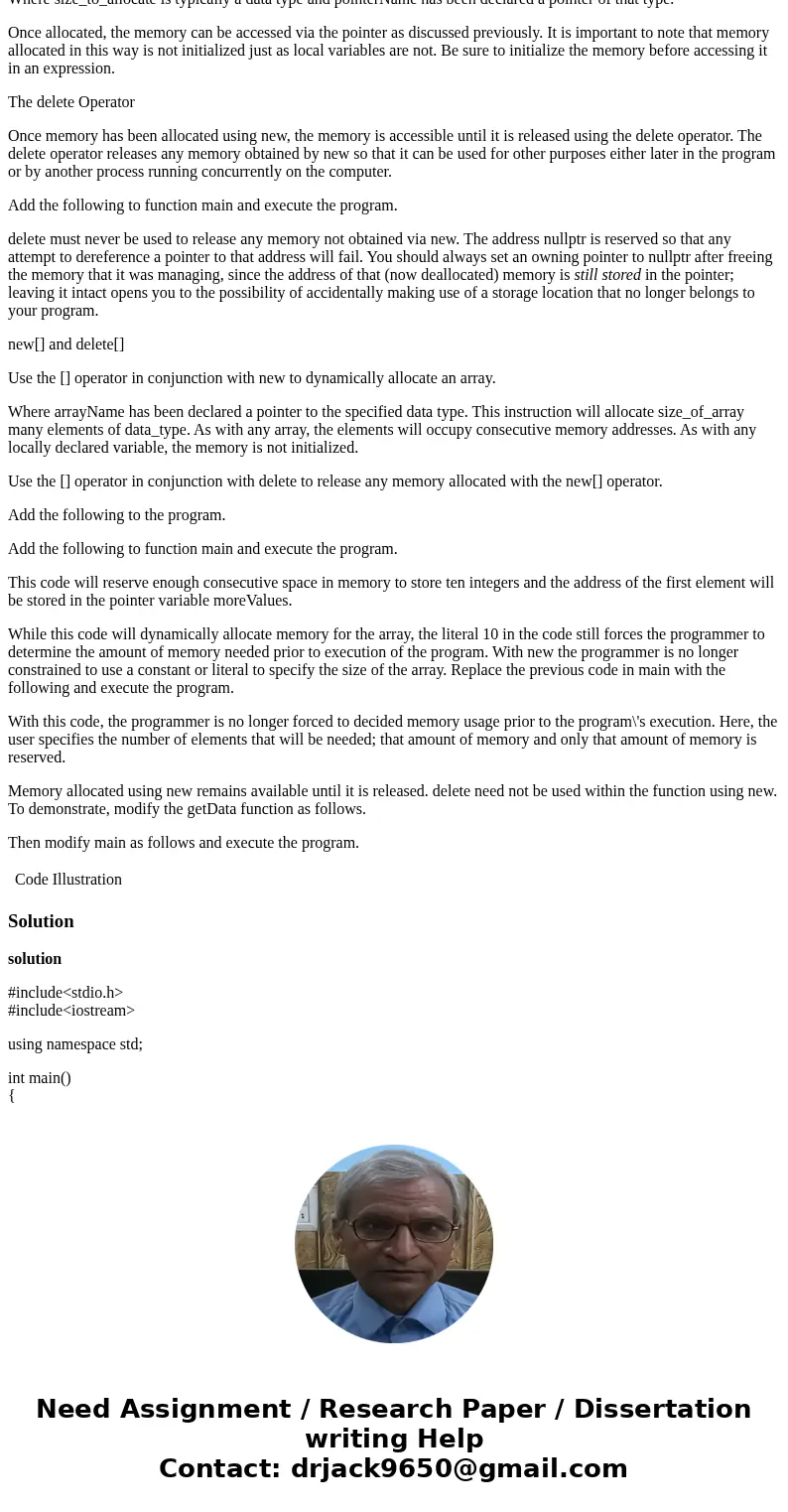
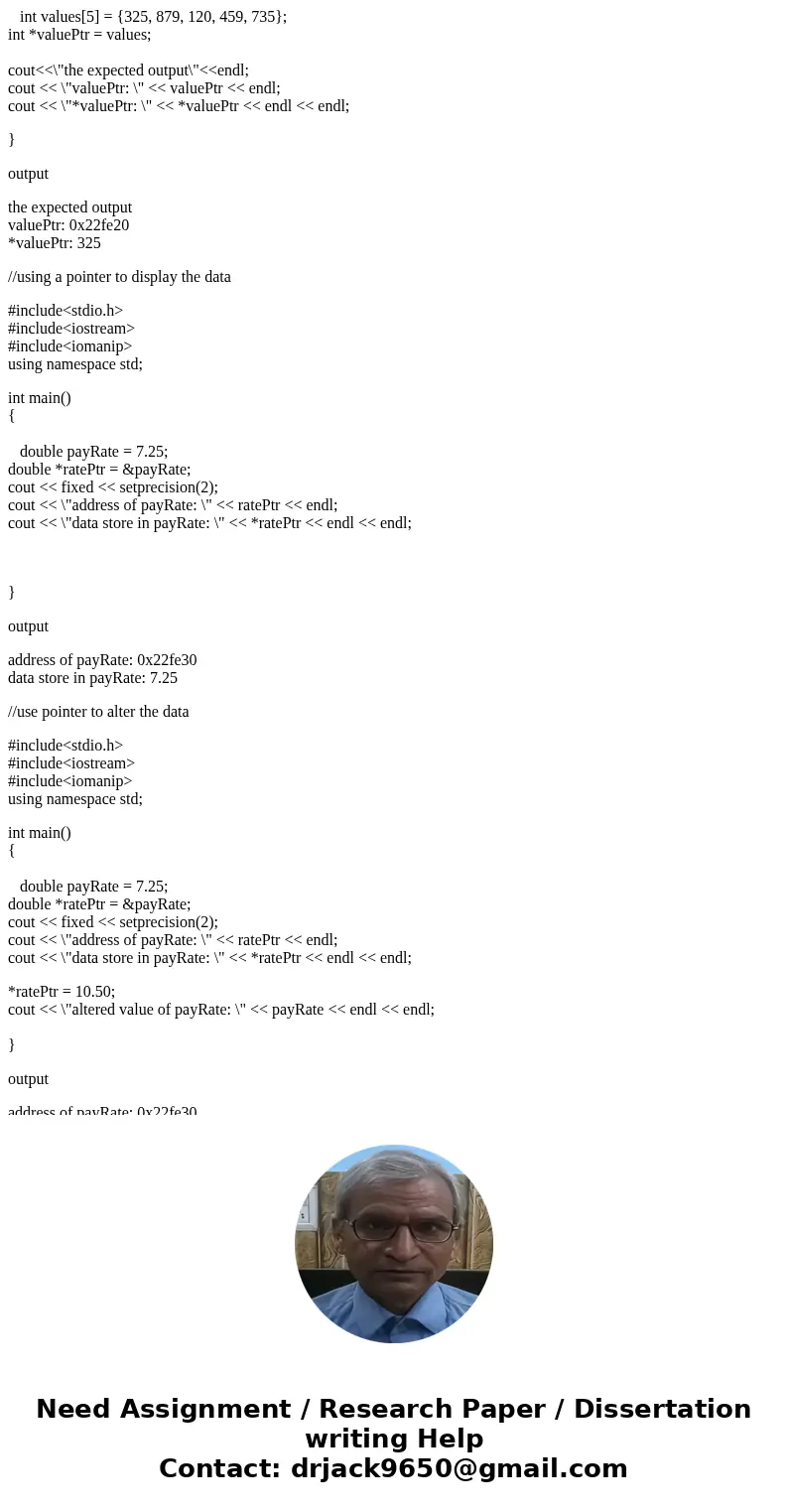
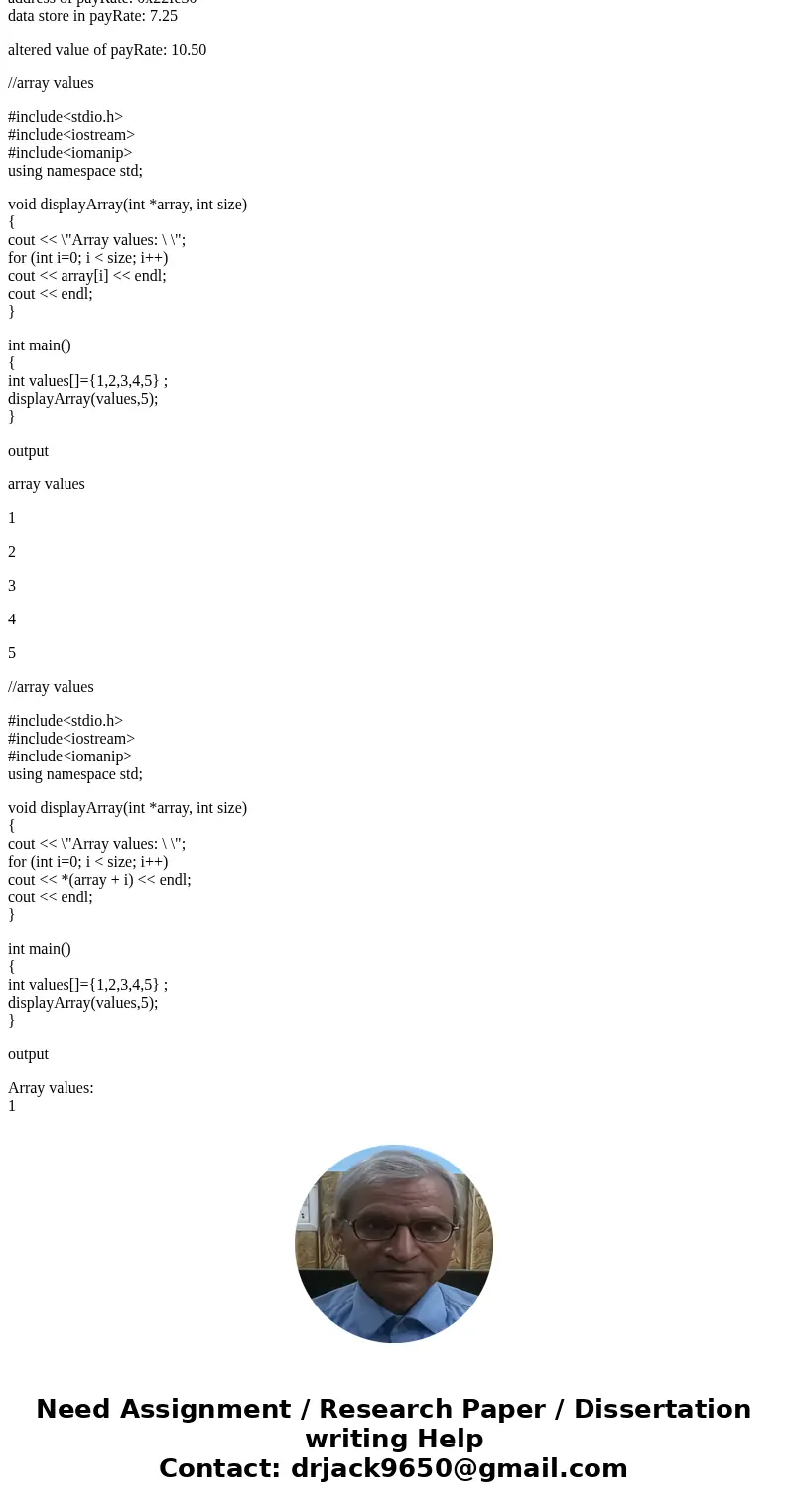
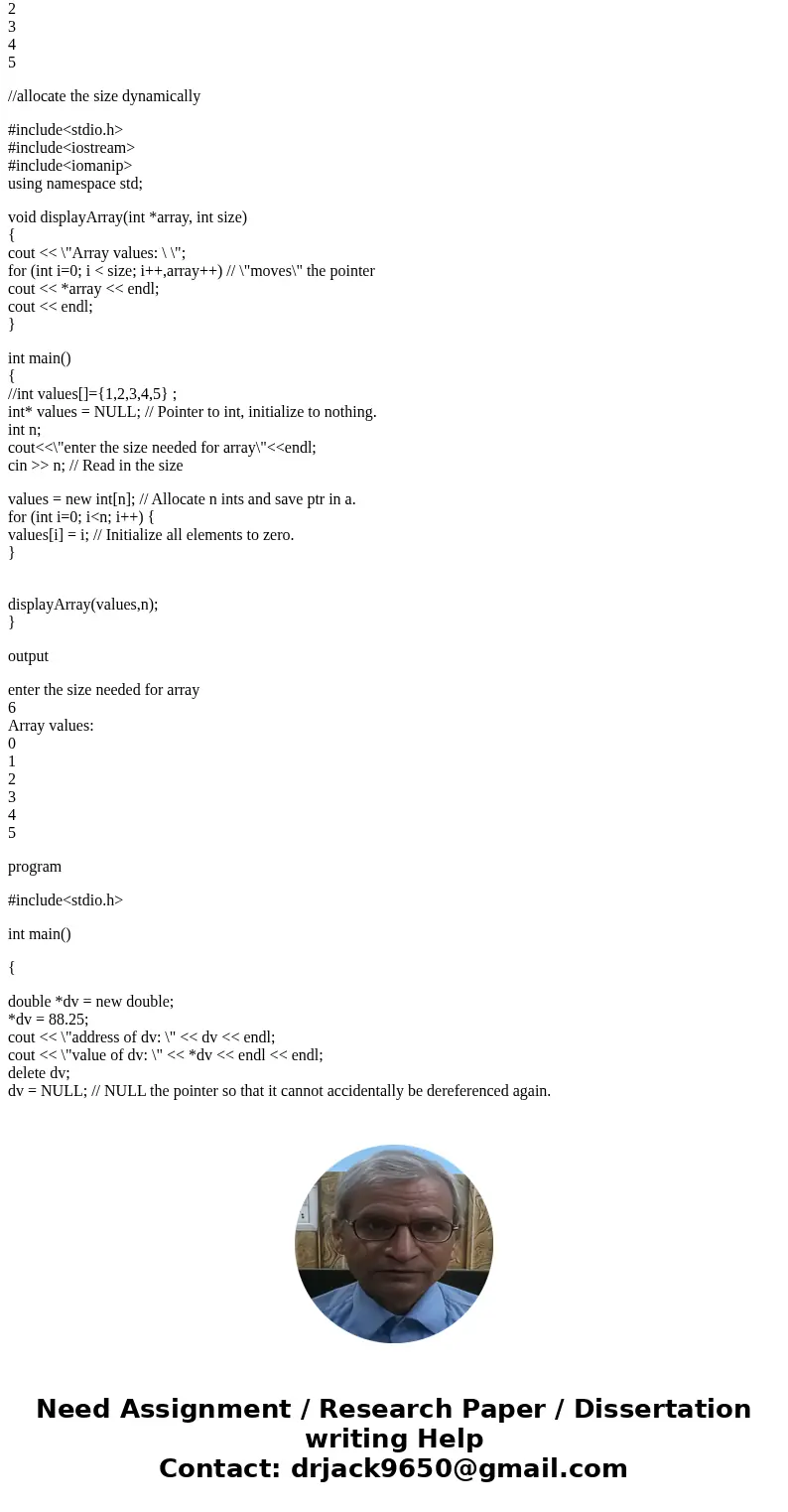
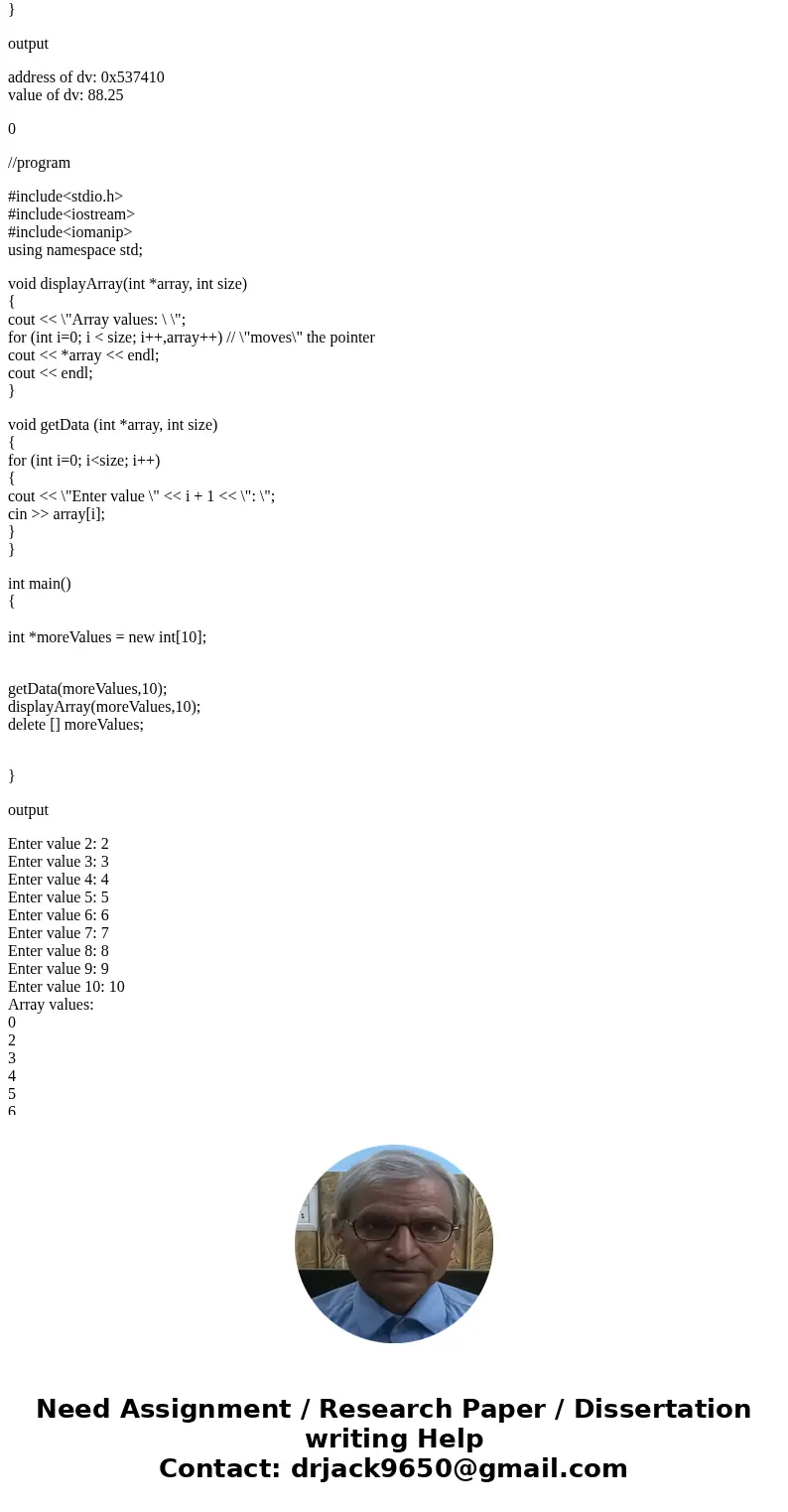
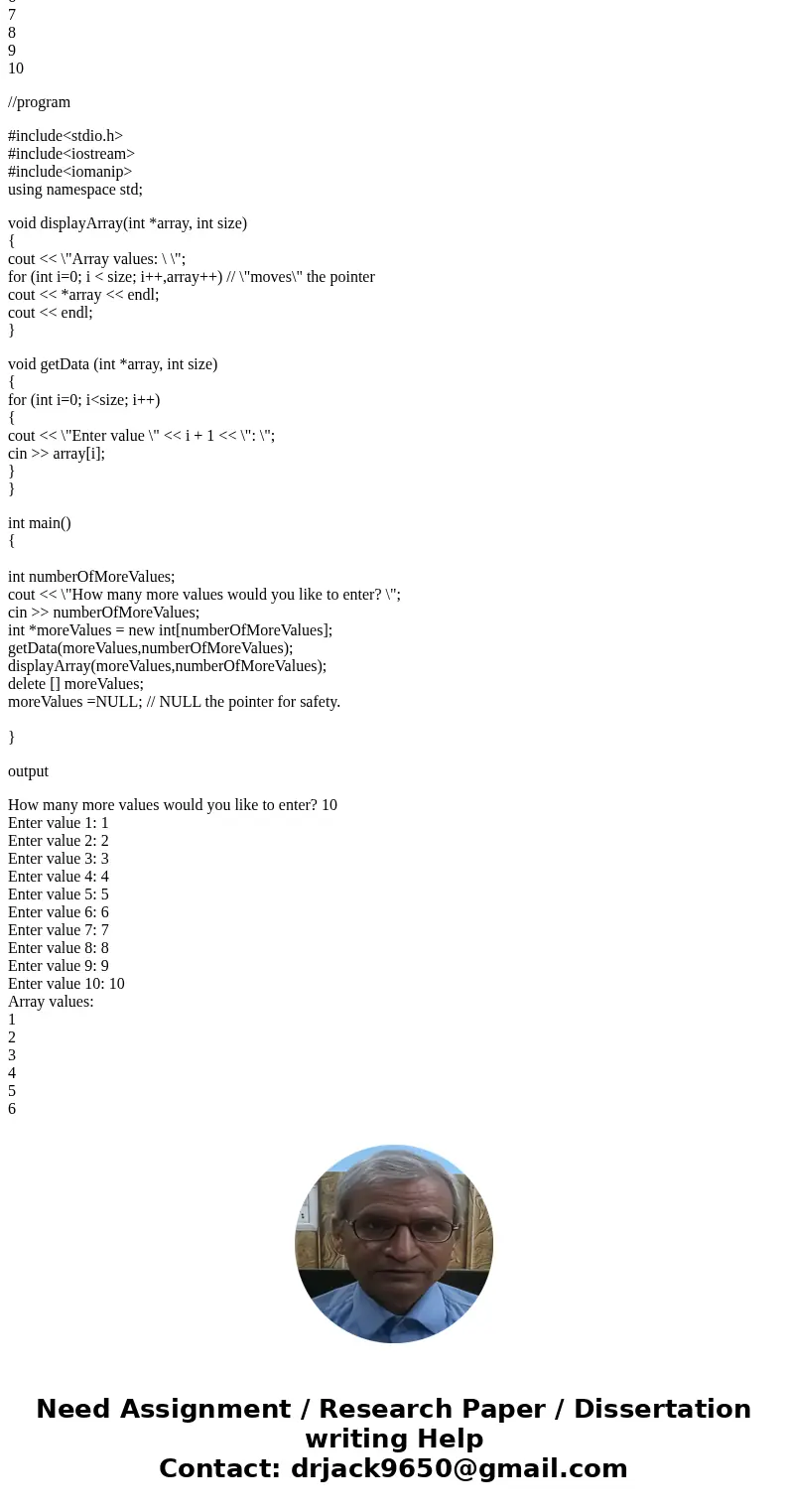
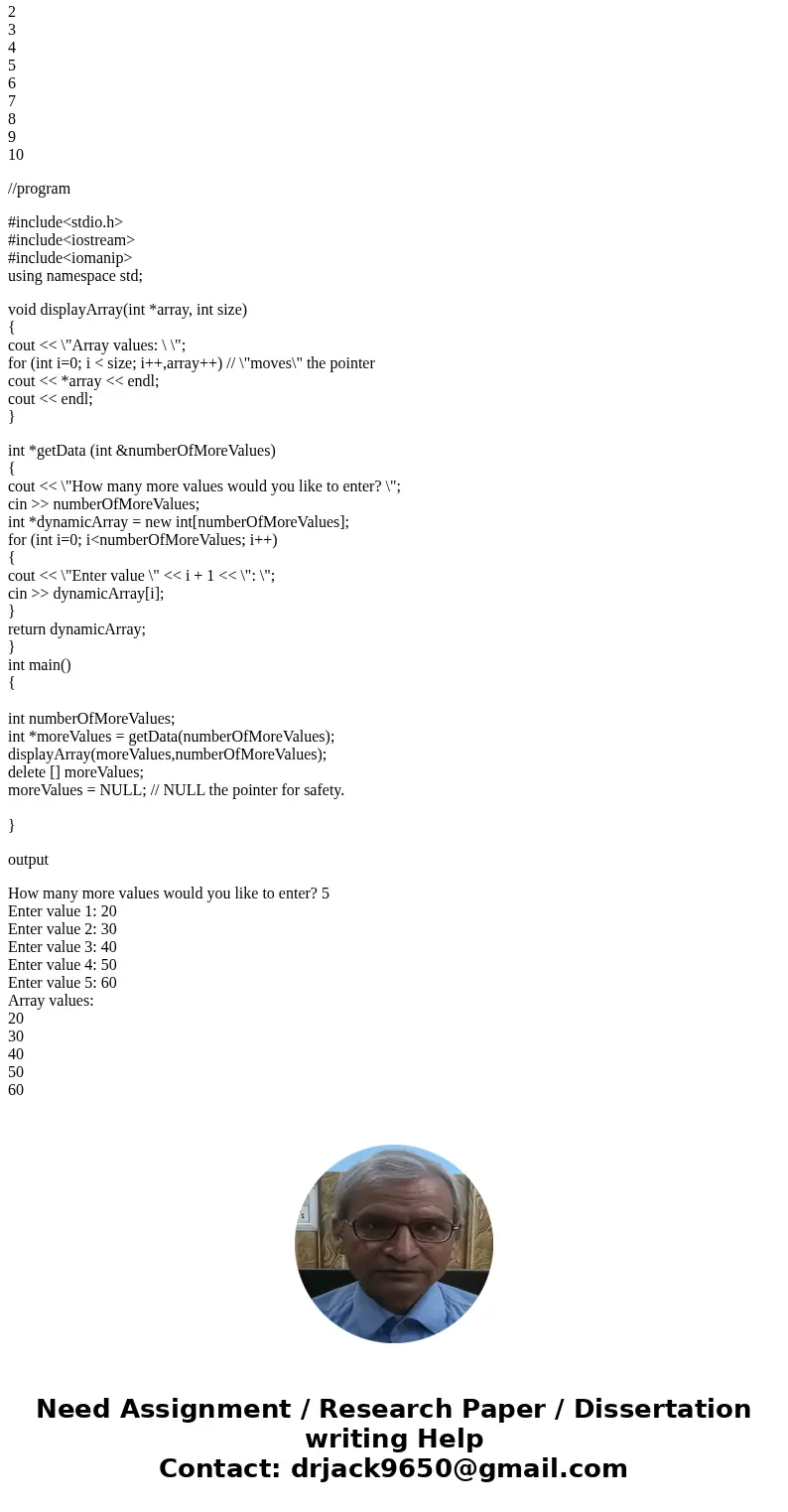
 Homework Sourse
Homework Sourse